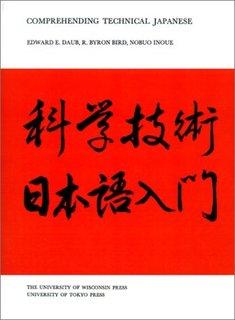 Comprehending Technical Japanese
Comprehending Technical Japanese

- Год выпуска: 1975 г.Автор: Edward E. Daub, R. Byron BirdИздатель: The University of Wisconsin PressФормат: DjVuКачество: Изначально компьютерное (eBook)Кол-во страниц: 438Язык: английскийУчебник предназначен, прежде всего, для учёных и инженеров, которым необходимо читать научно-техническую литературу на японском, но может быть полезен и более широкому кругу читателей, желающих повысить навыки перевода подобных текстов. Предполагается, что обучающийся уже владеет базовой японской грамматикой в размере одного учебного года. В учебнике встречается около 500 иероглифов, наиболее часто применяемых в физике, химии и биологии вместе с соответствующей лексикой. Уроки организованы так, что читатель запоминает необходимые кандзи путём многократного повторения. Также даются полезные грамматические конструкции, часто встречающиеся в научно-технических текстах. Большая часть текстов взята из японских учебников старшей школы и достаточна элементарна для технически образованного читателя.
TABLE OF CONTENTS
PREFACE 3
EXPLANATORY NOTES 6
LESSONS 1-25 11
APPENDIX A KANJI FREQUENCY LISTS 407 APPENDIX В THE FIVE HUNDRED KANJI TABULATED
ACCORDING TO ON READINGS 416 APPENDIX С THE FIVE HUNDRED KANJI TABULATED
ACCORDING TO STROKE COUNT 420 APPENDIX D THE FIVE HUNDRED KANJI TABULATED
ACCORDING TO NELSON'S RADICALS 424
APPENDIX E READINGS OF MATHEMATICAL EXPRESSIONS 429
APPENDIX F INDEX TO CONSTRUCTION EXAMPLES 431
APPENDIX G INDEX TO EXPLANATORY NOTES 433
APPENDIX H DICTIONARIES AND REFERENCE WORKS 436
PREFACE
Japan is one of the leading technological nations in the world. Although its scientific and engineering achievements have been most impressive, few scientists and engineers have developed the ability to read the literature of their Japanese counterparts. There are several reasons for this: (a) the extensive efforts of the Japanese to learn Western languages and their willingness to share their research results in those tongues; (b) the complexity of the Japanese language for foreigners; and (c) the absence of appropriate instructional materials for scientists and engineers. These points are discussed here briefly.
Although much of Japan's scholarly research has been published in English and other languages, there remains a vast literature of patents, handbooks, engineering journals, government reports, and transactions of technical meetings which is not normally translated. Furthermore there is substantial interest in graduate and postdoctoral study in Japan, joint US-Japan research projects, and multinational industrial ventures. All these activities serve to emphasize the need for providing more people with the opportunity to learn that part of the Japanese language which is vital to them, namely the technical part.
The Japanese used in modern technical writing is not nearly as difficult as that encountered in the literary or the spoken language. Written technical Japanese is considerably more direct in grammar and style than the literary language with its delightful nuances and tantalizing ambiguities. Large segments of Japanese grammar, such as humble and honorific verbs, irregular "counters", words for family relationships, the verbs for giving and receiving, the formulas for polite requests, and the whole hierarchy of greetings and apologies are entirely absent. Moreover, surprisingly, causatives, desideratives, alternatives, the -masu conjugation, and other verb forms do not occur frequently. The basic grammar needed to read scientific texts is remarkably limited and can be easily mastered. The big hurdle—and this cannot be minimized—is the development of a recognitional knowledge of the Chinese characters, the kanji.
Until the publication of this book there has been no reader designed specifically to meet the needs of the scientist or engineer. Concerned with the efficient use of his time, the technical man may wonder which of the approximately 2000 kanji he should learn first in order to gain access to Japanese technical literature. In the preparation of this book, therefore, we have stressed the mastery of the five-hundred most important kanji, and the scientific vocabulary which can be constructed from them.
The organization of lessons is such that the reader will learn these characters as a result of relentless repetition. To insure that we are introducing the most important kanji, we have made use of frequency counts which have been made
4 Comprehending Technical Japanese
on physics, 1 chemistry, 2 and biology texts. 3 We believe that the mastery of the five-hundred kanji emphasized in this book will provide a very sound basis for technical reading.
Assuming that the student has had a one-year course in beginning Japanese (basic grammar, the two капа systems, and the use of a kanji dictionary), we have structured the lessons in the following way:
1. At the beginning of each lesson a tabulation of the 20 new REQUIRED KANJI with ON and кип reading which are of importance for scientists and engineers is presented. These required kanji should be learned thoroughly; the reader is expected to recognize them in all subsequent lessons.
Next to each kanji two numbers are given. The upper one refers to the kanji designation in F. Sakade, A Guide to Reading and Writing Japanese, Tuttle, Rutland, Vt. (1959). The lower one refers to the number of the character in A. N. Nelson, The Modern Reader s Japanese-English Character Dictionary, Tuttle, Rutland, Vt. (1962). The Sakade book gives the stroke order and the most important readings; the Nelson reference gives a complete listing of the readings as well as a number of compounds.
2. Next the READING SELECTION, using the twenty new kanji, is given. Many of these texts are taken from high school books, which are less difficult and less formal in style than research journals or reference works. The subject material is rather elementary and hopefully the topics selected will also be of general interest. A vocabulary list, romaji version of the text, a complete translation, and explanatory notes accompany the reading selection. For this part of the lesson no effort is spared to help the reader.
Note that the vocabulary introduced in the reading selection willnot be repeated in later parts of the lesson or in subsequent lessons. Furigana will always be appended to kanji not previously included as required kanji so that the reader need not master these kanji and may concentrate on the required twenty in each lesson.
3. In each reading selection several constructions appear which recur frequently in technical reading. We single these out and give several examples further illustrating their use. These CONSTRUCTION EXAMPLES should be studied with great care, and any new vocabulary words introduced here should be learned thoroughly, for they will not be repeated subsequently.
4. Next several SUPPLEMENTARY READINGS are included. For these additional vocabulary is given but no other assistance. The new words introduced here need not be memorized. Many of these readings are taken from college
Preface 5
level textbooks, reference works, and technical journals. Their purpose is to provide additional experience in kanji recognition and comprehension.
5. The final essay is a TRANSLATION TEST. Here furigana are added to non-required kanji, but otherwise no help is given. The reader is on his own here—he may have to use a dictionary or grammar book to perform the translation. In this translation test each of the twenty required kanji for the lesson will appear at least once.
Thus each lesson progresses from elementary texts with considerable assistance, to more difficult readings with some vocabulary aids, and then on to a fairly realistic translation task with no help at all. The final essay should serve as a guide to the student in judging his mastery of the lesson and in deciding whether to move on to the next.
Although written primarily to assist the engineer and scientist in learning to read technical literature, the book may be useful to some technical people who are interested only in acquiring vocabulary for conversation purposes. Such people can take a "short course" by using just the romanized readings and the vocabulary lists. In addition several other groups of people might find this book helpful: technical librarians, who wish to translate titles and tables of contents; language majors, who want to train themselves to do technical translation; and students from non-English-speaking countries who plan to study technical subjects at Japanese universities.
Our primary purpose, however, is to provide the means for courageous scientists or engineers to learn to read technical Japanese by hard work. We trust this book will guide them through those first critical stages of learning to comprehend written technical texts and hope that the riches of Japanese scientific thought will be their reward.
N. I.
Madison, Wisconsin
ACKNOWLEDGMENTS
The authors wish to acknowledge financial support and encouragement provided by the Office of International Studies and Programs, the Engineering Experiment Station, and the Graduate School of the University of Wisconsin. In addition some financial aid was made possible to one of us (RBB) through the William F. Vilas Trust Estate. We are greatly indebted to Mr. and Mrs. Eiichi Hamanishi for preparation of the manuscript, to her for the calligraphy and typing, and to him for advice and proofreading.
1R.B. Bird, Scientific Japanese, Univ. of Wis., Engr. Expt. Sta. Report # 33, Part KJan.1967), and part II (Aug. 1967).
2N. Inoue, unpublished compilation.
3N. Inoue, unpublished compilation.
Информационный центр "Центральный Дом Знаний"
|
Comprehending technical Japanese |
|